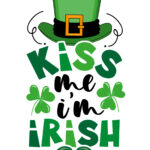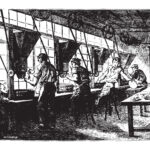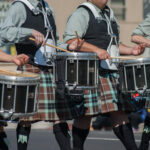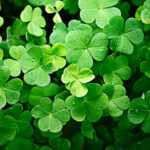 As the saying goes, “Everyone’s a little bit Irish on St. Patrick’s Day.” Now, we all know that isn’t true, but there is a large percentage of Americans with Irish roots. I have ancestors from Donegal. But where did the phrase originate? The main reason may be due to the significant Irish immigration throughout history and the widespread celebration of Irish heritage.
As the saying goes, “Everyone’s a little bit Irish on St. Patrick’s Day.” Now, we all know that isn’t true, but there is a large percentage of Americans with Irish roots. I have ancestors from Donegal. But where did the phrase originate? The main reason may be due to the significant Irish immigration throughout history and the widespread celebration of Irish heritage.
Why did so many risk everything to cross the Atlantic? The first answer most people cite is the Potato Famine or the Great Hunger. Between 1845 and 1852, a blight resulted in a catastrophic failure of the potato crop, the principal food crop of the Irish people. It is blamed for the death of over a million and caused over two million to emigrate, seeking a better life.
But even before the Potato Famine, life in Ireland had been marked by economic hardship, loss of land, and limited opportunities for many of the citizens. As Protestants moved in, discrimination against Irish Catholics threatened employment and land ownership. Wealthy English businessmen bought up the land, leaving tenant farmers poor and landless.

The rapid industrialization of the United States offered jobs and the chance for a better life. And the Irish poured into cities like New York, Boston, and Chicago. My family came to Philadelphia. Once an immigrant was established, they wrote to their friends and family back home, encouraging them to do the same, a system known as chain migration.
That promise of a better life in America led to one of the largest mass migrations in history, profoundly shaping the demographics and culture of both Ireland and the United States. So it is no wonder we celebrate St. Patrick’s Day here, too. But there are a few differences.
St. Patrick is the Patron Saint of Ireland, and many Irish honor his day in church before the celebrations, which tend to be more localized and focused on community. It is a day of religious observance for Catholics.
Both countries hold parades, but the United States, as usual, does it on a much larger and more commercial scale. Through marketing, St. Patrick’s Day has been widely promoted, becoming a commercialized holiday with widespread recognition. Businesses, bars, restaurants, and retailers capitalize on the holiday with green-themed decorations and merchandise.
Both countries are known for their parades; however, the largest in the world are held in New York, Chicago, Boston, Savannah, and Philadelphia. These are filled with decorated floats and bands playing Irish music. The Dublin Parade ranks 6th, and is typically more low-key, and features civic organizations and schools.
 The Wearing o’ the Green: Americans tend to wear a lot of green on St. Patrick’s Day, especially hats and t-shirts with leprechauns, Irish sayings, and shamrocks. Silly hats are also popular. The Irish do wear a bit of green, but it is not quite so over-the-top. Many will wear a simple sprig of shamrock as a subtle addition to their clothing, believing it makes them invisible to leprechauns who might otherwise pinch them.
The Wearing o’ the Green: Americans tend to wear a lot of green on St. Patrick’s Day, especially hats and t-shirts with leprechauns, Irish sayings, and shamrocks. Silly hats are also popular. The Irish do wear a bit of green, but it is not quite so over-the-top. Many will wear a simple sprig of shamrock as a subtle addition to their clothing, believing it makes them invisible to leprechauns who might otherwise pinch them.
The Shamrock: This is a symbol of both Ireland and St. Patrick’s Day. According to legend, St. Patrick used the three-leaved shamrock to explain the Holy Trinity. Wearing or displaying a shamrock is a common tradition on St. Patrick’s Day, symbolizing faith, hope, and love. In the United States, however, the shamrock has made its way onto everything, such as banners, shirts, hats, and so on.

Irish Music and Dance: Traditional Irish music and dance are central to St. Patrick’s Day celebrations. Cities on both sides of the Atlantic host concerts, performances, and ceilidhs (pronounced “kay-lee”) or dances where people can enjoy jigs, reels, and other traditional Irish music.
Green Beer: In the United States, it has become popular to dye beer green on St. Patrick’s Day. Bars and pubs may serve green beer to mark the occasion, adding a festive touch to the occasion. This, however, is rarely seen in Ireland.

Foods: Many restaurants offer Corned Beef and Cabbage. That dish is an Irish-American tradition. In Ireland, bacon and cabbage are more traditional, but Irish immigrants to the United States adapted the recipe as beef was more readily available. Baking Irish soda bread is another tradition. This bread is simple to make, using baking soda as a leavening agent, and is a staple of St. Patrick’s Day meals for many. These foods, also including Shepherd’s Pie, Colcannon Potatoes, black and white puddings, and Irish stew, are typically only eaten on March 17th in the United States. In contrast, in Ireland, these are typical everyday meals.
As you can see, the Irish brought their culture and traditions when they came to America. And in true style, Americans embraced it on a truly grand scale.

Another great article, informative, interesting and fun. Didn’t know about the pinch.
Thanks! I guess you’ve forgotten your daughter pinched you. Lol
How clever and practical of St. Patrick to explain the Holy Trinity using the three-leaf shamrock.
I thought so, too!